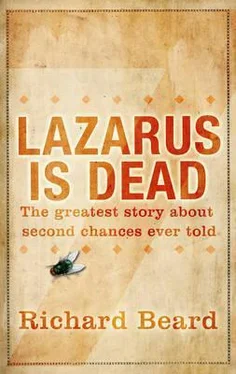They stare at each other, justifying to themselves the decisions of past lives. Lazarus reaches out and they hold each other close.
A messiah should marry, Lazarus thinks, for no better reason than the greed of human love. He wants Lydia near him, all the time. ‘We’ll announce the betrothal tomorrow, at Bethesda. I’ll walk around you seven times in front of a thousand witnesses. Our lives can change.’
‘Yes,’ Lydia says, ‘they can. But you shouldn’t look too far ahead.’
She presses against him, her belly against his hip, flesh against bone. He presses back, flesh against flesh. With Lydia he is a man not a god — a consolation to them both.
‘This is not the last time,’ Lazarus says. ‘I promise.’
‘That’s all I wanted to hear.’
‘We’ll start again. Wait until tomorrow. You won’t believe your eyes.’
6
On Sunday morning, reality asserts itself. Jesus is resurrected, and nothing is the same again.
As always, Jesus has learned from Lazarus: three days is the ideal period to stay buried. No one mentions the smell or speculates about the colour of his head, and three days fits with the prophecies in the Jewish scriptures. Jesus precludes as much doubt as he possibly can.
He also preserves his dignity. No one sees him leave the tomb, clumsy and stumbling in grave clothes. That would undermine the impact of the event. There is one further modification from the earlier resurrection of Lazarus. Jesus disappears immediately.
‘He has risen! He is not here’ (Mark 16: 6). Matthew agrees, ‘He is not here; he has risen’ (28: 6), while in Luke, ‘they found the stone rolled away from the tomb, but when they entered, they did not find the body of the Lord Jesus’ (24: 2–3). In John, Jesus tidies up and then vanishes: ‘[Peter] arrived and went into the tomb. He saw the strips of linen lying there, as well as the burial cloth that had been around Jesus’s head. The cloth was folded up by itself, separate from the linen ’ (John 20: 6–7).
In Nazareth, as a boy, Lazarus taught Jesus everything he needed to know. During his last week in Jerusalem, Jesus is still learning: life can be awkward the second time around. He exits the tomb and disappears.
In forty days from now, Jesus will ascend into heaven, his afterlife consistent with the pattern of his friendship with Lazarus. Jesus lets Lazarus go first. He pays attention. Then he does what Lazarus did, only better.
Cassius summons the soldiers charged with guarding the tomb. His lips are thin with rage but he lets them speak. Not one of them can give a reliable account of what has taken place.
In Mark, there is ‘a young man dressed in a white robe’ (Mark 16: 5) who somehow infiltrates the tomb. Cassius has the soldiers flogged. They add an angel — ‘His appearance was like lightning, and his clothes were white as snow’ (Matthew 28: 3).
Cassius seizes the flagellum himself and strikes hard behind the knees. Now there are ‘two men in clothes that gleamed like lightning’ (Luke 24: 4).
‘So which is it? One man or two? Angels or men? Young or old? You will tell me the truth.’
When the story changes to ‘two angels, in white’ (John 20: 12), Cassius turns and flails the wall, leaving the whip embedded in the plaster, at the centre of its own explosion of blood.
What is certain is that the body of Jesus is no longer in the tomb. Cassius urgently needs to find either the body or the man, for his own career and his own safety, but suddenly no one is even sure what Jesus looks like.
He is bearded, everyone agrees on that. But then he is encircled by a bright light, and Mary Magdalene who knows him well mistakes him at the empty tomb for a labourer — ‘Thinking he was a gardener, she said: Sir, if you have carried him away, tell me where you have put him’ (John 20: 15).
Cassius has every gardener in the city arrested. None of them are the resurrected Jesus. And then a strange story filters in from travellers using the Emmaus road: ‘As they talked and discussed these things with each other, Jesus himself came up and walked along with them; but they were kept from recognising him’ (Luke 24: 15–16). Cassius combines the uncertain descriptions with the consistent cases of mistaken identity. Jesus is in disguise.
Not that anyone knows where he is.
Cassius mobilises every soldier in the garrison to search for an escaped criminal. Whatever his outward appearance, he will be limping and possibly bleeding. Shouldn’t that be true? Cassius wants to check with Yanav, but Yanav too is missing.
If in doubt, the man they’re looking for will smell of myrrh and aloes.
He won’t get far. Checkpoints are double-manned. The sick are stopped at the city gates and searched.
Cassius cancels the Lazarus miracle at Bethesda. Instead he sends experienced legionnaires to raid the porches and turn out the invalids. Jesus is not found hiding among them.
Everyone pretends to be surprised. That’s one common thread. Jesus’s family and the disciples feign amazement at the empty tomb, but Cassius doesn’t trust them. To disappear so efficiently, Jesus must have made extensive preparations. This is a meticulously planned operation, and the work of more than one person.
If nothing else, the story of Lazarus has taught Cassius that Jesus uses his friends to achieve his objectives. Lazarus has questions to answer.
From Sunday morning the Lazarus story begins to fade. Lazarus has the star-bright birth in Bethlehem and the sheltered childhood in Nazareth. He comes from the line of David and enters Jerusalem on a donkey — but not elegantly, nor at the head of a procession, not in a way that three out of four gospel writers will choose later to remember.
For Lazarus, too many of the telling details are absent: the virgin-birth mother and the spectacular public death and the words to explain his experience. Nor does Lazarus ever understand the significance of hide-and-seek — he seeks when he should be hiding, and hides when he should seek.
Over the next forty days Jesus will make a limited number of appearances. The gospels have reports of Jesus with the disciples (behind locked doors, for security reasons), where he shows them his open wounds. In 1 Corinthians 15, Paul states that Jesus appeared to Peter, to the twelve apostles together, to more than five hundred followers at once, to James, and then once more to the apostles.
This last appearance, as noted by Paul, is probably the same as the story Matthew and John tell of Jesus on the shore of Lake Galilee. The disciples have been night-fishing, but as dawn breaks they have nothing to show for their efforts. Jesus appears on the shore, too far away to help. He shouts at them to fish differently, to throw their nets on the unconventional side of the boat. That’s where they find what they’re looking for.
On the beach Jesus lights a fire. They cook fish and they eat. Jesus offers them bread. On the rare occasions he does make himself known, Jesus, like Lazarus, is hungry.
Cassius attempts to use the disciples as a lure. He allows them their freedom because whenever Jesus appears the disciples are never far away. He has every disciple followed, and the entire garrison looking for a wounded bearded man, but Jesus continues to elude him.
Not so Joseph of Arimathea. He swears he is simply a friend, no more nor less. Cassius spits in his eye. Joseph of Arimathea is never heard from again.
As for Lazarus, it is inconceivable that he isn’t implicated. At the very least he advised on how to survive inside a tomb, and Cassius will not forgive him.
In the Antonia Fortress, in a small cell on the third floor, Cassius has the bed carried out. Lazarus will not be sleeping.
Читать дальше












